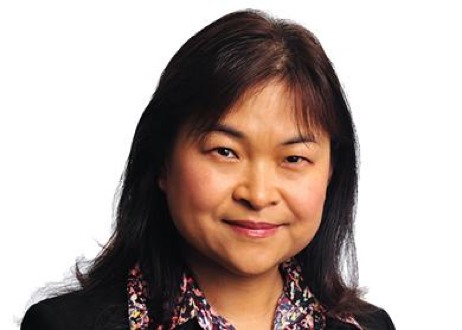
Talking with CBR’s Ellie Burns, the Splunk SVP of Security Markets talks about the need for accessible role models, growing up in China and why diversity and inclusion should begin in education.
EB: Why did you choose a career in tech/STEM?
HS: When I was growing up in China, science and engineering school was the aim for many, but the pinnacle of academic achievement was seen as going to medical school. I assumed I’d follow that path until I took my sister to a dental appointment which sealed my fate and made me realise I was not destined for a career in medicine.
I grew up on a college campus, where my father was a professor in electronic engineering and communications. My Dad went to the US as a visiting scholar in the 1980s and saw the effect that computer technology was having on his field. He encouraged me to major in computer science. My college entrance exam landed me as one of the top three students in Beijing, and got me admitted to Tsinghua University to study computer science, which was one of their top majors.

EB: What were the main challenges you faced at the start of your career and how did you overcome them?
HS: The challenges of being in a male dominated domain started before my career, when I was in university. When I studied at Tsinghua University, China’s top engineering school, 3% of students were female. I had to learn how to be comfortable and excel in an unbalance gender environment.
When I began my career in silicon valley, I was fortunate to work in companies where culture revolved around meritocracy. The first major challenge I faced was non-gender specific – how to break new ground in an established company. I worked for Informix (now IBM), where we set out to build a RDBMS product line for the federal market, amid a fast growing RDBMS business for the commercial market. This was unusual within the company, and we had to work extremely hard for credibility from our colleagues so our code and design changes would be accepted into the mainstream product.
EB: Tell us about your current role. What motivates you? What has been the driving force behind your career strategy?
HS: In my current role as SVP of Security markets at Splunk, I’m the general manager, essentially a CEO for Splunk’s security business.
I’m motivated by having the ability to put Splunk on the map for Cyber security. Splunk is at the epicentre of digital transformation. I want to help Splunk to continue to grow and create solutions that really help its customers, in one of the most challenging times for cybersecurity. The vantage point we sit at, leading a transformation of an industry, and truly impacting our customers on the journey, is very motivating!
My other main driver is the ability and desire to build teams. Few things are more satisfying than to get a team to the point where they love working with each other, celebrate each other’s success, and help each other to grow their careers. Enabling such teamwork is incredibly rewarding for me.
![]()
EB: What have been your most significant achievements in the IT industry in the past year?
HS: Splunk’s Adaptive Response Initiative launched last year, but it was three years in the making. It was fantastic to be able to build new solutions on a new platform and take a different approach to security. We wanted to show the market what analytics driven security can do – Adaptive Response uses behavioural analytics to more effectively connect intelligence across technologies to help organisations improve their security.
This is an achievement I’m really proud of because we lead the market by changing our approach to security and showed how adaptive response needs to be. The industry recognised this, and in the past year, others have started to change their approach. So yes, competition increased, but it was fantastic to receive recognition that Splunk is really working hard to help customers.
EB: What is your proudest achievement to date?
HS: Professionally, my proudest moments were when the National Diversity Council twice voted me as one of the 50 Most Powerful Women in Tech. It was a real honour and gave me a new platform to help encourage more women into tech.
On a personal level, I’m hugely proud of my children’s achievements. They’ve worked extremely hard, and are attending really innovative schools that can unleash their potential, and have great futures ahead of them.
EB: What is the biggest lesson you have learned in your career?
HS: At the beginning of my career, I had this notion that if you’re a woman, you just need to work really hard, and that’s all it takes to be successful.
As my career has progressed, observing other women’s careers and various company’s cultures, I have realised that it’s not just a case of working harder. The tech industry and the community within it need to help more talented, ambitious women begin their career in tech. That’s the key thing I’ve learned – that women in tech, who have managed to become successful, do not realise early enough that there are other women who need our help. We need to team up and help others, together.
EB: What would be your top tip for women looking to start a career in IT?
HS: To find something that you are passionate about. If you have passion, drive, and you know how to leverage resources and network, you will be successful, and your energy will be contagious. I also believe you should be comfortable and confident in the team you work in, which will help you and those around you progress.
EB: How would you encourage more women into the IT sector?
HS: The opportunity to contribute to the Tech=Icons series and answer these questions is a very important step. We need accessible role models who can show all the different roles that women in tech can have, who can share their struggles and successes and act as mentors to other women.
EB: How do you think businesses should approach diversity and inclusion?
HS: I think diversity and inclusion begins in education. I remember a recent study about CMU, where computer science majors previously required programming at a high school as a pre-requisite to apply, which resulted in only 5-10% of admissions being women. When the school realised that programming at high school wasn’t very accessible, they got rid of that requirement, and percentage of admissions that were women went up to 20%, and continued to grow.
To encourage diversity in tech, we need to ask how can we be more inclusive. Whether this is in education, selection criteria in recruitment, job-scope, or benefit programmes that female employees really care about. This can also be at a grassroots level – for example, at Splunk we have Employee Resource Groups, such as Pride@Splunk and WomenInTech@Splunk. Building a community who can support one another, help one another and celebrate each other’s success is vital to promoting diversity and inclusion.







